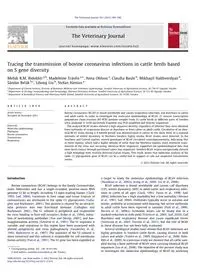
2012 Tracing the transmission of bovine coronavirus infections in cattle herds based on S gene diversity PDF
Preview 2012 Tracing the transmission of bovine coronavirus infections in cattle herds based on S gene diversity
Tracing the transmission of bovine coronavirus infections in cattle herds based on S gene diversity Mehdi R.M. Bidokhti a,b, Madeleine Tråvén a,⇑, Anna Ohlson a, Claudia Baule b, Mikhayil Hakhverdyan b, Sándor Belák b,c, Lihong Liu b, Stefan Alenius a a Department of Clinical Sciences, Division of Ruminant Medicine and Veterinary Epidemiology, Swedish University of Agricultural Sciences, SE-750 07 Uppsala, Sweden b Department of Virology, Immunobiology and Parasitology, National Veterinary Institute, Swedish University of Agricultural Sciences, SE-751 89 Uppsala, Sweden c Department of Biomedical Sciences and Veterinary Public Health, Swedish University of Agricultural Sciences, SE-75189, Sweden a r t i c l e i n f o Article history: Accepted 20 December 2011 Keywords: Molecular epidemiology Phylogeny Bovine coronavirus Transmission Respiratory a b s t r a c t Bovine coronavirus (BCoV) is found worldwide and causes respiratory infections and diarrhoea in calves and adult cattle. In order to investigate the molecular epidemiology of BCoV, 27 reverse transcription polymerase chain reaction (RT-PCR) positive samples from 25 cattle herds in different parts of Sweden were analysed. A 1038-nucleotide fragment was PCR amplified and directly sequenced. The analysed BCoV strains showed a high sequence identity, regardless of whether they were obtained from outbreaks of respiratory disease or diarrhoea or from calves or adult cattle. Circulation of an iden- tical BCoV strain during a 4-month period was demonstrated in calves in one dairy herd. In a regional epizootic of winter dysentery in Northern Sweden, highly similar BCoV strains were detected. In the Southern and Central regions, several genotypes of BCoV circulated contemporaneously, indicating that in these regions, which had a higher density of cattle than the Northern regions, more extensive trans- mission of the virus was occurring. Identical BCoV sequences supported the epidemiological data that inter-herd contact through purchased calves was important. Swedish BCoV strains unexpectedly showed a high homology with recently detected Italian strains. This study shows that molecular analysis of the spike (S) glycoprotein gene of BCoV can be a useful tool to support or rule out suspected transmission routes. � 2012 Elsevier Ltd. All rights reserved. Introduction Bovine coronavirus (BCoV) belongs to the family Coronaviridae, order Nidovirales and has a single-stranded, positive-sense RNA genome 31 kb in length, including 13 open reading frames (Clark, 1993; Saif, 2004). Variations in host range and tissue tropism of coronaviruses are attributed to the spike (S) glycoprotein (Galla- gher and Buchmeier, 2001). This protein is cleaved by an intracel- lular protease into two functional domains (Gallagher and Buchmeier, 2001). The S1 subunit is peripheral and responsible for virus binding to host-cell receptors (Kubo et al., 1994), induc- tion of neutralizing antibodies (Yoo and Deregt, 2001), and hae- magglutination activity (Schultze et al., 1991). The S1 sequence is variable, and mutations in this region have been associated with altered antigenicity and virus pathogenicity (Fazakerley et al., 1992; Ballesteros et al., 1997). The sequence of the S2 subunit is more conserved and this subunit is responsible for cell membrane fusion activity (Yoo et al., 1991). The S1 gene has been exploited as a target to study the molecular epidemiology of BCoV infection (Hasoksuz et al., 2002a; Jeong et al., 2005; Liu et al., 2006). BCoV infection is found worldwide and causes calf diarrhoea (CD), winter dysentery (WD) in adult cattle, and respiratory infec- tions in cattle of all ages (Clark, 1993; Paton et al., 1998; Saif, 2004). Infection has a high morbidity but a low mortality (Alenius et al., 1991; Saif, 2004). Outbreaks typically occur in autumn and winter, probably in association with housing, but severe outbreaks in adult cattle have been reported in summer (Park et al., 2006; Decaro et al., 2008a). Economic losses can be heavy due to a marked reduction in milk yield (Tråvén et al., 2001; Saif, 2010). Calf diarrhoea and respiratory disease also cause significant losses (Svensson et al., 2003; Torsein et al., 2011), but the role of BCoV in these diseases has not been fully evaluated. Several serological studies have shown that BCoV infections are highly prevalent in Swedish cattle herds, causing disease in both calves and adults (Tråvén et al., 1999; Hägglund et al., 2006; Bido- khti et al., 2009). In a previous study we showed that all cattle sam- pled during a herd outbreak of BCoV were carrying identical BCoV sequences (Liu et al., 2006). The objective of the present study was to investigate the molecular epidemiology of BCoV by analysing 1090-0233/$ - see front matter � 2012 Elsevier Ltd. All rights reserved. http://dx.doi.org/10.1016/j.tvjl.2011.12.015 ⇑ Corresponding author. Tel.: +46 18 671782. E-mail address:
